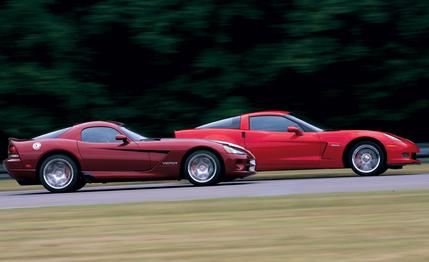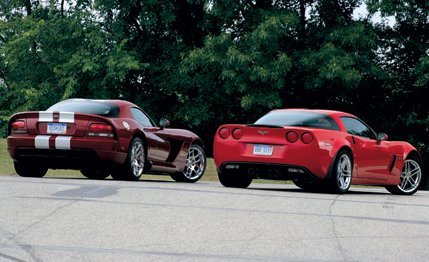 Comparison Tests
Comparison Tests


Consider the car market as an amusement park. Every vehicle has an analogous ride, from the Tilt-A-Whirl Lotus Elise to the Jungle Cruise Ford Taurus. The Dodge Viper and the Chevrolet Corvette Z06, then, can feel a bit like driving the Raptor. It's an experience not unlike doing motorcycle wheelies on a freeway. In short, driving hard in a car with 500-plus horsepower is not for the fainthearted. The appeal is an addictive mixture of scaring yourself within inches of your life and laughing at how easily you can get away with it. Both the Viper and the Vette have this characteristic in spades.
The last time these two cars met ["Motor City Bullies," December 2005], the Z06 beat the Viper handily on the road, track, and drag strip. Since then, the 505-hp Z06 hasn't changed much, aside from revised rear shocks, although the price has crept skyward. The 2007 Z06 seen here starts at $70,000, but options such as heated seats, a premium stereo, extra sound insulation, chrome wheels, and navigation bring the as-tested total to $77,230.

The Viper SRT10, on the other hand, has received a thorough makeover for 2008 in both coupe and roadster form.
The only visual change is a new hood with functional vented gills, and this achieves the seemingly improbable feat of making the Viper look even more aggressive. The V-10 engine has been bored out an extra 0.6 millimeter to increase the displacement to 8.4 liters. It also gets variable valve timing [see Tech Highlight], new cylinder heads, a new intake, electronic throttle control, hollow intake valves, coil-on-plug ignition, a 10.2:1 compression ratio (up from 9.6), and a larger oil pump with a swinging oil pickup. The result is 600 horsepower and 560 pound-feet of torque, improvements of 90 horses and 25 pound-feet. At 2500 rpm, the Viper makes more torque than the Z06 does at its peak.

The Viper's cabin remains unchanged but is much cooler now that the exhaust flows straight to each side pipe instead of crossing under the passenger compartment.
The Tremec T56 six-speed manual gearbox gets a revised shift linkage, triple-cone synchros, and a twin-disc clutch that has 18-percent-less rotational inertia than the previous single-disc setup. At the rear there's a new speed-sensing limited-slip differential. On the suspension front, the Viper gets new Michelin Pilot Sport PS2 tires set up with more negative camber, new shocks, higher spring rates, and a solid rear anti-roll bar replacing the previous hollow one.
The good news is that these changes come cheap. The Viper's base price of $86,845 is $150 less than that of the Viper in our last test, thanks in part to a lower gas-guzzler tax. And even at the as-tested price of $91,145, the Viper is the most affordable 600-hp car on the market.
For this evaluation, we performed our standard battery of performance tests and some real-world driving, and then we drove to Grattan Raceway Park to see how each car would handle the bumpy 2.0-mile road course. As it turns out, all the changes to the new Viper aren't enough to better the Corvette, but the Z06's claim to the title of America's top sports car is looking a bit tenuous. Read on for a full explanation.